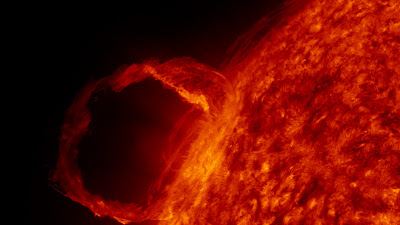 Like all other stars before it, and all those that will come after it, the Sun was born in a nebula, surrounded by thick, massive clouds of cosmic dust and hydrogen gas. It first ignited some 5 billion years ago, alongside tens to thousands of other stars, all of which must be of similar age and chemical makeup. Now, in the first-ever complex study on the issue, astronomers begin looking for the Sun's siblings, in a research that could ultimately provide us with more clues as to how the solar system evolved over time, Technology Review reports.
Like all other stars before it, and all those that will come after it, the Sun was born in a nebula, surrounded by thick, massive clouds of cosmic dust and hydrogen gas. It first ignited some 5 billion years ago, alongside tens to thousands of other stars, all of which must be of similar age and chemical makeup. Now, in the first-ever complex study on the issue, astronomers begin looking for the Sun's siblings, in a research that could ultimately provide us with more clues as to how the solar system evolved over time, Technology Review reports.When compared with other yellow dwarfs, as well as with other objects in this part of the Milky Way, the Sun exhibits an unusually-high concentration of metallic elements. This abnormality has puzzled astronomers for many years, and it's now believed that identifying the star's birthplace could help unravel this enigma as well. For all these reasons, researchers at the Missouri State University, led by expert Anthony Brown, conducted the first serious astronomical search for the stars that appeared at the same time our own celestial fireball did. Unfortunately, the results are not encouraging.
The main issue plaguing such an effort is the magnitude of the needed search. Recent data on how nebulae function reveal that some stars may be ejected from within their nurseries as if sprayed from a cosmic hose. This means that their formation process is very chaotic, and also implies that our star's siblings may be spread apart over distances exceeding 3,000 light-years. Covering such vast distances is like looking for a needle in a haystack, given that the area contains an estimated 100 million stars. Of these objects, astronomers have accurate information on just 100,000 of them, which is a small portion of our solar system's neighborhood.
There is no reason to disappoint, however. Though a Sun sibling has not been found within 100 parsecs from our star, astronomers take comfort in the fact that the year 2012 will see the launch of the Gaia spacecraft. The instrument will be the successor of the Hipparcos space probe, which is responsible for providing experts with most data on the 100,000 stars analyzed until now. Gaia will conduct the first decent-quality 3D investigation of the Milky Way, and will map more than 1 billion stars. However, we will have to wait until 2020 for this census to be done.
0 comments:
Post a Comment